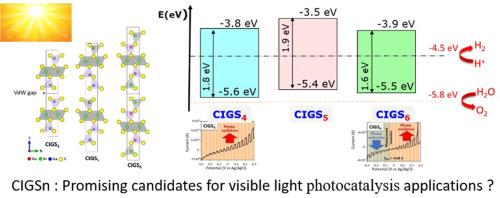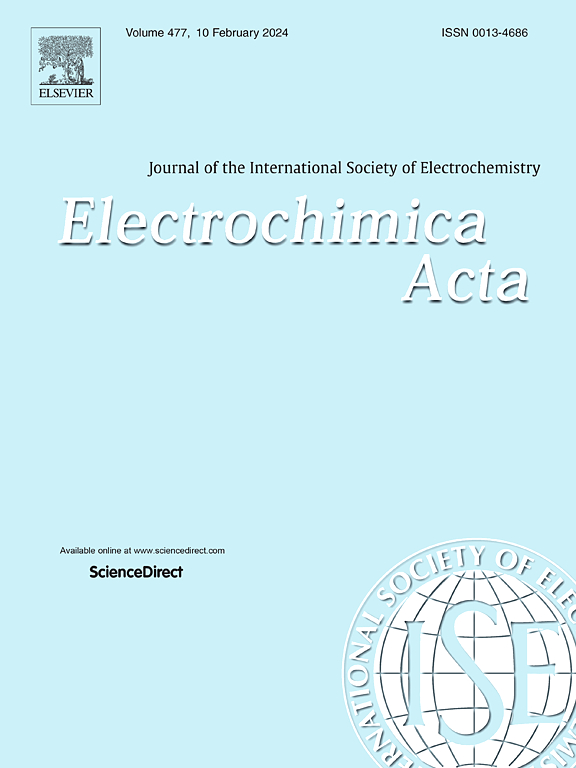Photo-electrochemical characterization of CIGSn lamellar compounds: potential candidates for photoinduced applications
IF 5.5
3区 材料科学
Q1 ELECTROCHEMISTRY
引用次数: 0
Abstract
Metal chalcogenide semiconductors are being widely investigated for applications in solar energy conversion, such as photovoltaics and visible light photocatalysis. Herein, an initial assessment of potentialities of new lamellar chalcogenides named CIGSn is provided, while comparing them with that of the well-known CIGS chalcopyrite. The main difference between CIGS and CIGSn compounds concerns their electronic properties and more precisely the nature of charge carriers. Cu0.32In1.74Ga0.84S4 (CIGS4) is an n-type semiconductor, unlike the chalcopyrite CuIn0.7Ga0.3S2 (CIGS) that is a p-type semiconductor. More noticeable, Cu1.44In2.77Ga0.76S6 (CIGS6) and in a lesser extent Cu0.65In1.75Ga1.4S5 (CIGS5), exhibit an ambipolar character with a slight predominance of electron transport. The Fermi levels of all lamellar CIGSn compounds are similar (-4.5 eV) and higher that of the chalcopyrite CIGS (-5.1 eV). In addition, the charge carrier densities of CIGSn compounds (1014–1017 cm−3) are significantly lower than that of CIGS (1020 cm−3), which is consistent with their higher resistivity. Photoluminescence measurements and OCP decays suggest much more in-gap defect states in the lamellar compounds. These results suggest that CIGSn compounds would not be suitable for photovoltaic applications. Nevertheless, their energy bands show an interesting positioning, with respect to redox potentials involved in water splitting and CO2 reduction. In addition, ambipolarity could enhance the efficiency of catalytic reactions, because a type of minority charge carriers does not limit the charge transport.

CIGSn 片状化合物的光电化学特性:光诱导应用的潜在候选者
人们正在广泛研究金属卤化物半导体在太阳能转换(如光伏和可见光光催化)中的应用。本文初步评估了名为 CIGSn 的新型片状铬化物的潜力,并将其与著名的 CIGS 黄铜矿进行了比较。CIGS 和 CIGSn 化合物的主要区别在于它们的电子特性,更确切地说,是电荷载流子的性质。Cu0.32In1.74Ga0.84S4 (CIGS4) 是一种 n 型半导体,而黄铜矿 CuIn0.7Ga0.3S2 (CIGS) 则是一种 p 型半导体。更值得注意的是,Cu1.44In2.77Ga0.76S6(CIGS6)和少量的 Cu0.65In1.75Ga1.4S5(CIGS5)都表现出电子传输略占优势的双极性。所有片状 CIGSn 化合物的费米水平都相似(-4.5 eV),但高于黄铜矿 CIGS 的费米水平(-5.1 eV)。此外,CIGSn 化合物的电荷载流子密度(1014 - 1017 cm-3)明显低于 CIGS(1020 cm-3),这与其较高的电阻率相符。光致发光测量和 OCP 衰变表明,片状化合物中有更多的隙内缺陷态。这些结果表明,CIGSn 化合物不适合光伏应用。不过,它们的能带显示出与水分离和二氧化碳还原所涉及的氧化还原电位有关的有趣定位。此外,由于一种少数电荷载流子不会限制电荷传输,因此伏极性可以提高催化反应的效率。
本文章由计算机程序翻译,如有差异,请以英文原文为准。
求助全文
约1分钟内获得全文
求助全文
来源期刊

Electrochimica Acta
工程技术-电化学
CiteScore
11.30
自引率
6.10%
发文量
1634
审稿时长
41 days
期刊介绍:
Electrochimica Acta is an international journal. It is intended for the publication of both original work and reviews in the field of electrochemistry. Electrochemistry should be interpreted to mean any of the research fields covered by the Divisions of the International Society of Electrochemistry listed below, as well as emerging scientific domains covered by ISE New Topics Committee.
 求助内容:
求助内容: 应助结果提醒方式:
应助结果提醒方式:


